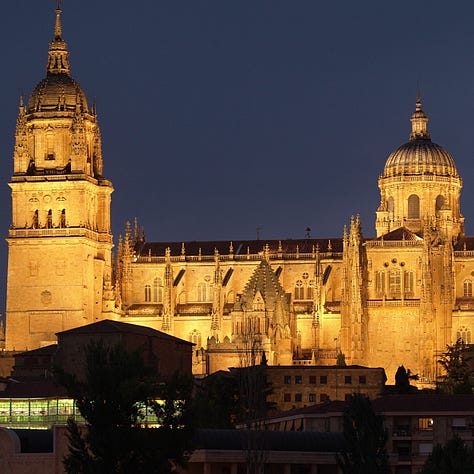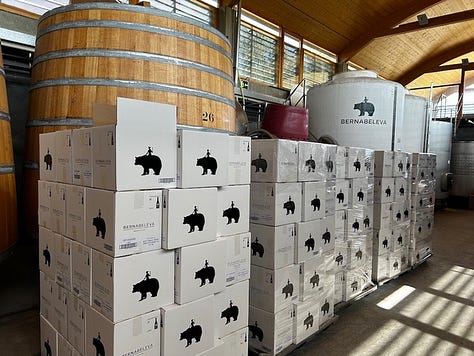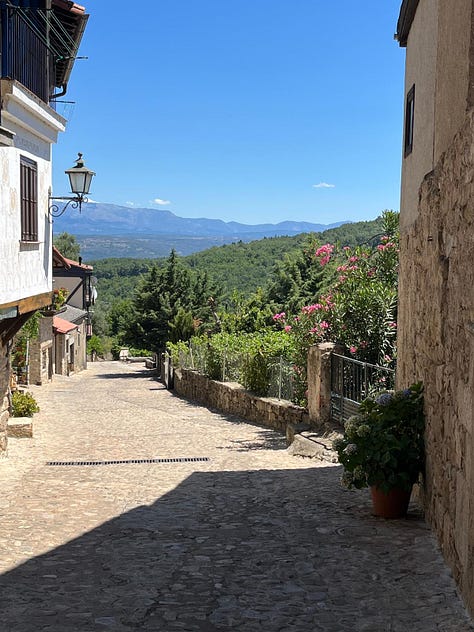🚀 Madrid Is Now the Top City for the World’s Ultra-Rich
Plus: Could the next pope be Spanish? (Probably not.)
Madrid | Issue #99
🇪🇸 The Bubble is Spain's #1 English-language newsletter. We offer paid subscriptions and we’d be thrilled to have your support!
Your rent will go up by the time you read this headline
💸 Madrid Is Now the #1 City for the World’s Ultra-Rich

Madrid locals have long suspected something was up. The sudden appearance of boutiques selling €9 green juice to people in activewear who don’t sweat; the non-stop rotation of cranes in Chamberí; the Instagrammed interiors with too much travertine.
But now, it’s official. Madrid has been crowned #1 on the Barnes Global Property Handbook’s 2025 ranking of cities most popular with Ultra-High-Net-Worth Individuals (UHNWI, aka the 0.001% with a net worth ≥ $30m).
Yes, Madrid. Not Paris. Not Dubai. Not New York. Madrid.
The rich property bible says… We covered Barnes’ annual handbook last year, when Madrid rose from 9th to 4th, and this year’s version, announced in February and presented in April, couldn’t give more love to “Cosmopolitan, cheerful and lively” Madrid.
So who’s buying? Mostly very rich Latin Americans and Europeans who’ve discovered that Madrid has all the quality-of-life benefits of, say, Milan, but without the Milanese prices—or Milanese attitudes.
Dropping mad cash. Barnes says these buyers are snapping up high-ceilinged, move-in ready flats in Salamanca for up to €16,500/m², dropping €5-6m on apartments like it’s nada. And then? Buying another one. For 💩 and giggles.
Well, we like it too. According to Barnes Spain boss Alvise Da Mosto, the city offers “a high standard of living, an international airport 15 minutes from the center, [top-tier] healthcare and international schools and a very efficient infrastructure.” Also, there is sunshine, security, and a low inheritance tax. (Gracias, Ayuso.)
The new word is “super-gentrification”. We’ve now reached a kind of final boss decadence stage of urban transformation, Universidad de Zaragoza sociologist Daniel Sorando tells ElDiario. We may no longer be in a standard gentrification scenario but something deeper, darker: what Loretta Lees, director of the Initiative on Cities at Boston University, has identified as super-gentrification, where even the old rich get edged out by the new super-rich.
Think: families with 90m² apartments in Salamanca being priced out by families who already own a 90m² apartment—and are buying a 250m² one next door, just in case.
A few highlights of the new Madrid. Or lowlights, if you’re looking for an apartment normal people can afford.
Prices. Apartment prices in lujo Justicia y Cortes are rising 20% per year 💰😱. Like, seriously. In Chamberí, a nice flat is now €6,500/m² to €13,000/m², depending on whether it comes with a terrace, a doorman, or a lingering memory of what the neighborhood used to be.
Screw the mortgage. Half of all property sales in 2024? Paid in cash.
Lest we be accused of insensitivity. We know real estate prices have gone cray cray in regular Spain too, and we’ve written about it many times. One stat: Overall Madrid house sale prices have gone up 22.7% per m² in the last year. 😭
And no, chavalín, Golden Visas are not the cause. In fact, the national government scrapped the Golden Visa program (it officially ended April 3), but Barnes ain’t stressed. As they helpfully point out, “80% of our Venezuelan and Mexican clients already have Spanish or Italian passports.” Lucky you…
But what about the rest of Iberia? It’s…up and down. 🤷
Marbella’s all growed up. The lujo capital of the Costa del Sol jumped from 47th to 35th place.
But Barcelona is sliding—from 19th to 22nd place in the rankings. Why? Policies designed to slow housing speculation. (Imagine!)
And don’t even mention Lisbon. It dropped from 8th to 25th 📉. Why? Portugal eliminated the Golden Visa for home buyers. And honestly, Lisbon is over. (¡Ojo! This is a cautionary tale, Madrid!)
Madrid: “But enough about you, let’s talk about me.” The Barnes report wraps it up with a question: What does €1m get you in Madrid today? The answer: “An 80m² renovated apartment in one of the most sought-after neighborhoods, provided you can find it.” Ouch.
So your new neighbor? Yes, he probably is an ultra-rich crypto refugee from Argentina.
But don’t worry—they’re only in town for three months. And their cousin already bought the unit below. 😭
More news below. 👇👇
🔔 But first, check out our sponsor—with an offer for Bubble readers






Iberian Wine Tours has a special offer for Bubble readers on one of its excellent and exclusive wine adventures—The Golden River Tour from Madrid to Porto in May 2026. (For objective, third-party praise, check out the gushing commentary and 147/151 5 ⭐ reviews on Feefo.)
Would you like to come along? Bubble subscribers have the chance to get in on this very intimate tour with a double discount—a $100 early bird discount for those who sign up before May 1, and another $100 off for Bubble readers with code BUBBLE100.
💬 Five things to discuss at dinner parties this week
1.🍾 IMF: Spain is only major economy upgraded in 2025
The world is full of chaos and economic downgrades, but it looks like we’re sorta getting a promotion.
The International Monetary Fund (aka IMF) this week revised its global growth forecast downward due to the escalating tensions and economic uncertainty surrounding the Trump tariffs. But guess which country not only is escaping the chopping block but actually getting a pat on the back? That’s right: Spain.
Down! The U.S., Canada, the U.K., Germany, and Japan all saw their growth projections for 2025 cut. The IMF’s global growth forecast is down to 2.8%, with U.S. growth slashed by nearly a full point to 1.8%
…and Up! but Spain’s was revised upward to 2.5%, the highest among all major advanced economies.
That’s not just good. That’s three times the expected growth of the eurozone average (0.8%). Yippee-Ki-Yay, Motherf*ckers.
So… why is Spain thriving? Tapas and tintos de verano. There are a few reasons that explain this, and some of them are, well… uniquely Spanish.
Spain is not that into America (at least not economically). Spain’s limited trade exposure to the U.S. means it’s mostly dodging fallout from Trump’s tariffs. While other economies get slammed, Spain looks like the shrug emoji. 🤷♂️
It exports more sun and lifestyle than semiconductors. Spain’s biggest export isn’t a car. It’s tourism. And that’s booming (we’re now the second most visited country in the world after France and may be #1 in 15 years). Just about everyone is still flocking to Spain’s beaches, cities, and mountains. Winning!
That being said, Spain also makes a lot of cars. We are Europe’s #2 car producer after Germany. The difference is that Spanish cars mostly stay in Europe while Germany’s go global, and that’s why they are now in tariff trouble.
Post-flood reconstruction is (unfortunately) good for GDP. We are still reeling from the DANA storms that wreaked havoc in late 2024. The silver lining? Reconstruction is pumping public and private investment into the economy.
A jobs machine, partly powered by immigration. Spain’s labor market is surprisingly hot. Immigration has helped fuel job creation, particularly in services and tourism and that’s a double win for growth.
What the IMF is saying. Spain gets multiple shoutouts in the IMF’s World Economic Outlook and that’s a rare praise for any economy right now (especially when you consider Spain was once the eurozone’s sick man).
Praise. Petya Koeva-Brooks, deputy director at the IMF’s Research Department on Tuesday called Spain’s upgrade “a rare occurrence within the many downgrades that we’ve had for other countries” and attributed it to Spain’s “strong momentum in 2024” and also to (as we said) “very strong services exports” and “very strong labor accumulation” partly related to immigration.
Woohoo! (For now, at least).
2.🪖 PM Sánchez pledges record military spending. His junior partners aren’t having it
Surprise! Prime Minister Pedro Sánchez has announced that Spain will sorta stop freeloading on NATO and hit the group’s target of spending 2% of GDP on defense this year (four years earlier than planned), thanks to a €10.5bn boost to military spending that will bring the total to €33.1bn in 2025.
Big move. Last year, Spain was at the bottom of NATO’s military spending rankings; according to official data, it only allocated 1.28% of its GDP to defense , making it the lowest among all 32 NATO member countries.
How? Sánchez insisted that “not one cent” of the new spending “will be taken from social programs”—and it won’t require new taxes. 🤔 Instead, he says the funds will come from leftover budget allocations and unused EU pandemic recovery funds. You know, like coins in the couch.
Change of heart. Pressure to hit the 2% goal has been mounting within NATO and the EU, and recently Sánchez began making noises about being willing to make it happen. “If you had asked me years ago, my answer would have been different,” he said Tuesday. “Today the reality is different.” How? Putin and Trump.
Not a coincidence. Wednesday was the deadline for NATO countries to submit their military spending forecasts for this year.
Where’s the money going? One-third of the additional €10.5b will go to improving conditions and salaries for military personnel, while another third will go to telecommunications and cybersecurity (Sánchez called this Spain’s “digital shield”).
Not many guns. Only 18.7% of that amount (€1.96bn) will be allocated directly to buying defense stuff (new weapons systems, including howitzers, vehicles, and upgrades to the Army’s aging armored fleet).
Unhappy partners. The decision has triggered an internal crisis in Sánchez’s coalition (yes, another one). Some of the parties in the leftist Sumar alliance are unhappy, though they are unlikely to act on said unhappiness.
Complaints. Lefty Izquierda Unida (IU) called the plan “unilateral and irresponsible” and demanded an urgent Sumar coalition meeting 😱. IU and far-left Podemos also condemned a separate €6.6m arms deal with Israel, calling it “complicity in genocide.” IU wants the contract annulled — or the Defense and Interior Ministers to resign (which won’t happen).
Cue the Pope. Gabriel Rufián of the ERC Catalan leftish separatists (and always good value) mocked Sánchez on X: “He's capable of instituting three days of mourning in a secular state for the death of a pacifist Pope, and during those three days announcing an additional €10bn in arms spending,” he wrote. “Pure Sánchez.” 🍿
3. 👼 A Spanish Pope? Unlikely… but we can dream
Both Bubble founders were living in Argentina in 2013 when Jorge Bergoglio was named Pope Francis, and let us tell you, it was nutty. One minute, you’re eating a milanesa napolitana, and the next every media outlet from CNN to the Telegraph is calling to ask what the heck is a Bergoglio?
Unlikely, but… It’s unlikely that the next pope will be Spanish—you’ve all seen the candidate lists and the betting markets, with two Italians and a Filipino leading the pack—but hey, that’s why
they lipsync for their liveshold a conclave.Dark horse. Without further ado, let’s talk about Spain’s very dark horse—Francisco Javier Bustillo. Or, as the French call him now, François-Xavier.
So who is Francisco Javier Bustillo? He was born in Arre (Navarra), likes chistorra and Osasuna, que nunca se rinde (sorry, cryptic soccer joke), and entered the seminary at 10.
A Franciscan friar, a lover of tennis, and a man who describes his Renault Clio as “his hermitage,” Bustillo worked his way through the Church ranks in France, co-refounding a convent in Narbonne and eventually becoming bishop of Corsica.
Bustillo is known for his charisma, his sharp takes on Corsican autonomy and immigration, and his habit of giving interviews that make secular France nervous.
The Francis connection. Bustillo caught Pope Francis’s attention after writing a book on the priesthood that urged a return to a Church of the people. Francis loved it. He called him personally, kept in touch, and two years after naming him bishop, made him a cardinal. The romance was sealed.
How deep is that friendship? Last December, Pope Francis skipped the ultra-glitzy reopening of Notre Dame—and then went to Corsica. Why? Because Bustillo invited him to a low-key event on “popular religiosity in the Mediterranean,” with local songs, youth groups, and zero ministers in suits. "The Pope sees authority as standing among the people, not above them," Bustillo told France 3. The Pope agreed.
Macron likes him too. The French president made an official visit to Bustillo’s bishop’s palace in Ajaccio, much to the horror of France’s secular commentariat. Macron left announcing a boost in Corsican autonomy. (Bustillo 1 – Élysée 0.)
Too young for now. At 56, Bustillo is way below the unofficial age floor for a pope (usually 70+). "He’s a chavalico [youngster]!" one old Bustillo friend told El Español. That means he's almost definitely not this pope—but maybe the next-next pope?
Bustillomania. In Corsica, he’s a celebrity. In Paris, a curiosity. In Spain, the quiet navarro hope. And in Pamplona, where he returns regularly to say Mass and visit family, he’s still the guy who told a childhood friend: “Don’t worry about coming to church. I’ll meet you at the bar.”
Because of course he did. He’s a Franciscan. And he’s very, very navarro.
4. ✈️ The Trump Trade for Spaniards? Skip U.S. travel
You will be excused for not being shocked by this. But it seems that Spaniards are kinda, sorta, a little put off by the stories of random travelers being locked up for weeks when they arrive in the U.S., on account of having committed terrible crimes no reason whatsoever.
So guess what? They’re not visiting the Land of Uncle Sam.
Hard pass. According to Spain’s tourism industry association, La Mesa del Turismo, Spanish travel to the U.S. has dropped 15% this year—despite a favorable euro-dollar exchange rate and some pretty good deals on flights.
So, what gives? One word: Trump. 🎃
Or rather, a phrase. “The impact of the political and economic situation”, said Mesa president Joan Molas, who also cited “media and political noise” around Trump.
Can’t help. Spanish travel plans probably aren’t getting a lift from the general environment of airport interrogations and random detainments. (Apparently, having your social media use investigated for six hours in the Orlando airport doesn’t feel muy Disney.)
Meanwhile, Americans keep coming here. Bigly, as a certain Bad Orange Man would say.
Record breaking. Spain welcomed a record-breaking 93.8m tourists in 2024, including 4.26m Americans—an 11.2% jump over the year before.
Big spenders. According to INE, international tourists dropped €126.3bn last year (up 16.1%), with the sector making up a whopping 12.9% of GDP (and projected to hit 13.2% in 2025, per Caixabank).
So yes, it’s awkward. We love your money, America, but we’re less keen on your airports.
Where are Spaniards going instead? London, Rome, Paris, Marrakech, Tokyo. All the hits. All the good times. None of the ICE drama.
Will this reverse? Maybe. Molas calls the drop “circumstantial.”
But for now. It looks like Spain will be keeping distance in this relationship—always hosting, rarely visiting, and politely declining the invitation to spend Easter being grilled about why his ESTA says “student” but his phone holds pictures of a visit to Beirut.
5. 🗣️ Does it count as equal time if men and women talk over one another?
Ever wondered whether men or women talk more on Spanish TV? Probably not, since you maybe assumed the answer was obvious. Or maybe you’ve watched enough tertulias (news panel shows) to know that no one ever really talks more—because everyone is shouting over each other all the time anyway.
Spain’s TV channels are about to find out. The CNMC (that’s Spain’s competition watchdog) is going to count. Like, literally count. Starting June 1, they’ll launch a €121,000 project to clock just how much airtime goes to men vs. women in the news broadcasts of seven national channels, including TVE, Antena 3, Telecinco, and Trece TV. 🙃
Why are we doing this? The whole thing traces back to 2022 and then-Economy Minister Nadia Calviño, who famously swore she’d never again appear on a panel where she was the only woman. “There are many events where I’m the only woman,” she said, “because I’m the minister.” Fair.
New law. With a hat-tip to Calviño, that same year Spain passed the Ley General de Comunicación Audiovisual, which states (Article 6.1, if you're into that sort of thing) that TV must project an “equal and non-discriminatory” image of women and men—and not, you know, quietly let men hog the mic.
Chatty Kens. A study of talking time on news broadcasts in Catalan TV in 2003-2005 found men had around 75-80% of talk time ‼️
There will be counting! So the CNMC has now been tasked with writing an annual report on how women are represented in audiovisual content. That includes counting how much they speak in “news programs, current affairs, and commercial communications.” (We hope they get hazard pay for the tertulia bits.)
What does that mean in practice? Starting June 1, it means someone’s job will be to sit and watch 250 hours of Spanish news programming—about 1,000 clips of 15 minutes each—and log every second of male vs. female speech. 😭 A custom spreadsheet will track each “actor’s speaking time,” per the CNMC’s specs. (They’ll probably want to define “speaking” carefully—will Belén Esteban’s loud tears count?)
And then? If the CNMC finds “manifest situations of inequality,” fines can range from €60,000 to €1.5 million. That’ll buy a lot of airtime.
Ze French. Oh, and if you think this sounds a bit French—oui, it is. France’s media regulator has been tracking gender balance on screen since 2014. It’s a thing.
Will Spain’s broadcasters pass the test? Will it spark an arms race of female pundits? Will tertulias remain nearly unintelligible? Stay tuned.
🔔 Before you go, check out our Instagram account
If you’re not following us on Instagram yet, you’re missing out. We’re posting exclusive content with our collaborators across Spain, breaking news updates, and pop culture coverage. Click on the post above and come hang with us!




